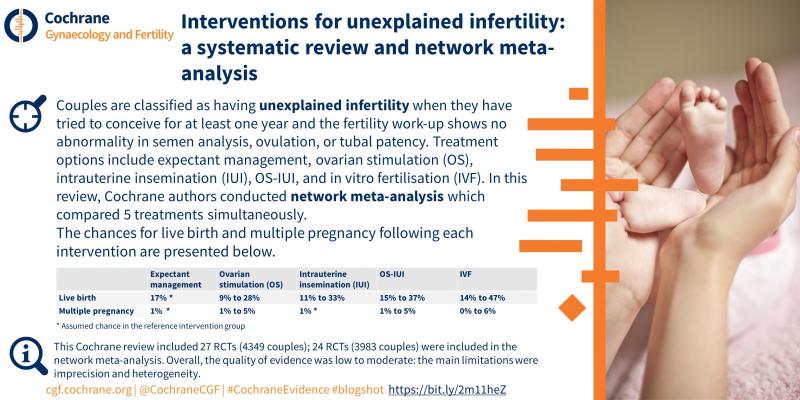
Couples are classified as having unexplained infertility when they have tried to conceive for at least one year and no abnormality in semen analysis, ovulation, or tubal patency has been identified. Treatment options for unexplained infertility include expectant management, ovarian stimulation (OS), intrauterine insemination (IUI), OS-IUI, and in vitro fertilisation (IVF) with or without intracytoplasmic sperm injection (ICSI). Cochrane authors conducted network meta-analysis on interventions for unexplained infertility.
Cochrane Gynecology and Fertility sat down with Dr Rui Wang, the lead author of the study, who answered their questions and shared some details about the network meta-analysis they conducted and what was found.

Rui Wang is a research fellow at Department of Obstetrics and Gynaecology, Monash University. He has recently completed his PhD on the application of evidence synthesis methods in reproductive medicine at The University of Adelaide. He is a trainee scientific editor for BJOG. His research interests include evidence-based women’s health, RCTs, and evidence synthesis methods.
What was the research question?
There are five commonly used treatment strategies for couples with unexplained infertility, including expectant management, ovarian stimulation (OS), intrauterine insemination (IUI), OS‐IUI, and in vitro fertilisation (IVF) with or without intracytoplasmic sperm injection (ICSI). Among these five treatment options, which one is the most effective and safe option?
What is network meta‐analysis?
Network meta‐analysis (NMA) synthesises evidence of comparisons that have been compared directly or indirectly for the same clinical condition and therefore allows simultaneous comparison of multiple treatment options.
How is NMA different from regular meta-analysis? What are the advantages of this method?
Pairwise meta-analysis allows the comparison of two interventions at a time while network meta-analysis allows multiple comparisons. If two interventions have not been compared directly, pairwise meta-analysis cannot estimate the difference between these two interventions. However, In a network meta-analyses, if two interventions have both been compared with the same third intervention, the difference between these two interventions can be estimated.
How did you and your team decide on this approach?
There are five interventions of interest: expectant management, ovarian stimulation (OS), intrauterine insemination (IUI), OS‐IUI, and IVF with or without ICSI. Thus doing multiple pairwise meta-analysis between any two interventions does not seem to directly guide clinical decisions. Moreover, in some comparisons, there are either no studios or the number of studies is limited. Therefore, NMA is the best approach in this scenario to account for both direct and indirect comparisons, and to allow the comparisons of multiple interventions simultaneously.
What were your findings?
Evidence of differences in live birth between expectant management and the other four treatments (OS, IUI, OS‐IUI, and IVF/ICSI) was insufficient. Compared to expectant management/IUI, OS may increase the chances of multiple pregnancy, and OS‐IUI probably increases the chances of multiple pregnancy. Evidence showing differences between IVF/ICSI and expectant management for multiple pregnancy was insufficient.

Is there anything else you would like to add?
As unexplained infertility is a broad definition, the treatment effects of these interventions may vary in different couples. We found in our sensitivity analysis that in couples with poor prognosis of natural conception, OS-IUI and IVF/ICSI increased live birth rate compared to expectant management. However, this should be interpreted with caution and needs to be confirmed in future trials.

